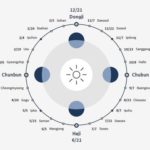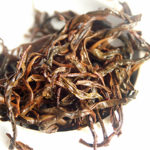„A long time ago in Hadong – a steep mountain region – there were little to be offered to the king. After a long contemplation, people gathered tea leaves that grew between the rocks and presented them to the king, which he liked and bestowed the title „tea of kings“.
Frist Tea Field and an Ancient Tea Tree
Hwagae-myeon located in Hadong county is known as the first Korean region to plant tea trees and is recognized for hand-made tea production. It is surrounded by Jiri Mountain in the altitude of 1,2 km.
In Dosim Dawon at Hwagae-myeon, there is an ancient tea tree called Korea´s Oldest Tea Tree or Thousand-Year Tree, and there i salso the original tea field in Ssanggye Temple, a Buddhist temple of 1000 years history. It represents the history of not only Korean tea as such but as the first region in Korea which grew tea plants. The tea field is mainly placed along the banks of Seomjin River on the slopes of southern edge of Jiri Mountain. Tea trees growing between rocks and create beautiful picturesque landscape pictures.
During the Japanese colonial era when the cultivation of native tea species came under a threat, people of Hadong strived together to protect the autogenous tea plants and thwart the influx of the Japanese species. Today, Hadong preserves the native species tea plants unlike other tea fields in Boseong and Jeju and is recognized for the greater value accordingly.
In the third year of King Heungdeok in Silla Dynasty (828 AD), Lord Daeryeom – the envoy to the Tang Dynasty China – brought back seeds, which were planted in Jiri Mountain by the order of the king and thrived.
Coexistence of the tea culture and Buddhist culture in Hwagae
In the past, Hwagae-myeon was a village with many buddhist temples and monks, and buddhism – reffered to as Jirisan buddhism – flourished in the region. Before the modern days, the buddhist temple was in charge of managing the tea fields in Hwagae-myeon and the nearby regions, and the traditional tea of Hadong became known throughout the country thanks to the buddhist monks. Even today, there is an extensive area of tea fields near the Ssanggye Temple and Chilbul Temple.
Natural agriculture methods and tea picking in the slope
With the fresh air from Jiri Mountain and moisture from Seomjin River, Hadong has the excellent natural environment to grow tea trees thanks to its geographical characteristics, minimizing the artificial management of tea field by the locals and prompting the harvest of tea leaves in their natural condition.
Tea trees usually grow sporadically in the slopes on the lower edges of the mountain, making the leaves difficult to harvest via machinery. Therefore, the tradtitional method of harvesting by handpicking each leaf is maintained to this very day.
Hand-made tea, from beginning to the end
The tea leaves, handpicked one by one, are then hand-roasted on the iron pan or something resembling an iron kettle. The method of hand-roasting tea used in Hadong is the same as the traditional method recorded in Dongdasong, a book written by the Seon monk Cho Ui, who established Korean tea ceremony.
The whole process of making the hand-roasted tea happens during 48 hours and is directly dependend on weather. Since the harvest time is quite short – from April to June – limited amount of tea is produced. The hand-roasted Hadong tea is highly evaluated in Korea itself as well as by tea lovers worldwide.
Lifestyle and Customs
The traditional tea agriculutre of Hadong is directly related to livelihood of the locals and coexists culturally with it as well, evident in different kinds of literature, oral tradition, and everyday customs.
Gogu and Tea Ceremony
Each April, Hadong tea farmers perform a rite to pray for a bountiful harvest of tea at the place tea trees were first planted. The ceremony of offering the new crop of tea picked before Grain Rain to the Buddha happens on April 20th or 21st. The sixth solar term in the lunisolar calendar, known as Gogu in Korean, Gogu = Grain rain (first spring rain for farmers).
Hwagae Elementary School even holds a special course on the value of tea and tea ceremony, included in the curricilum as „the happy school in harmony with tea aroma“. It is a part of the effort to preserve the unique Hadong tea culture.
Seasons
Borrowed from China, the Korean 24-point lunisolar agrarian calendar divides the year (visualized as the elliptical path of the Earth around the Sun) into 24 equal segments, each marked by a significant astronomical or agrarian event. Because the Earth’s speed along this elliptic is not constant through each of the 24 segments, the calendar dates of the 24 points vary slightly from year to year.
For the tea harvest, we are only concerned with the late spring and early summer points on the calendar, as shown in the table below, beginning with Gogu and ending with Haji. See the table.
| Season Name | English Translation | Date | Chinese | Korean |
| Gogu | Grain rain (first spring rain for farmers) | April 20 or 21 | 穀雨 | 곡우 |
| Ipha | Beginning of the summer season | May 5 or 6 | 立夏 | 입하 |
| Soman | Grain full (grains are plump) | May 21 or 22 | 小滿 | 소만 |
| Mangjong | Grain in ear (awns are growing) | June 5 or 6 | 芒種 | 망종 |
| Haji | Summer solstice (longest day of the year) | June 21 or 22 | 夏至 | 하지 |
Types of Korean tea
The most famous green tea of Korea – Nokcha is harvested in April. first pluck is called Ujeon and is recognised for it´s specific delicate taste and aroma. It is picked and processed before Gogu (20th of April), the so called Grain Rain, first spring rain. There is also a second pluck – Sejak (after Gogu, late April) and then comes third pluck Jungjak (around 20th of May) and summer fourth pluck Daejak (around 21st June). An excellent semi-oxidized tea – Hwangcha, yellow tea, is famous for the wonderful fully rounded and sweetish flavour. Korean powder tea is called Malcha and is delicate.
We can not picture the magnitude of 1000 years old Korean tea culture in one grasp, but we can start with appreciating Korean tea delicacy. Discover Korean teas with us, and we promise you will not regret it!
- Jirisan slopes
- Harvest
- Map
- Korean tea tools
- Buddhist monks
- Nokcha Ujeon
- Nokcha Ujeon
- Nokcha Ujeon
- Hwangcha – yellow tea
- Hwangcha – yellow tea
- Hwangcha – yellow tea
- Tea in a gift packing






















































